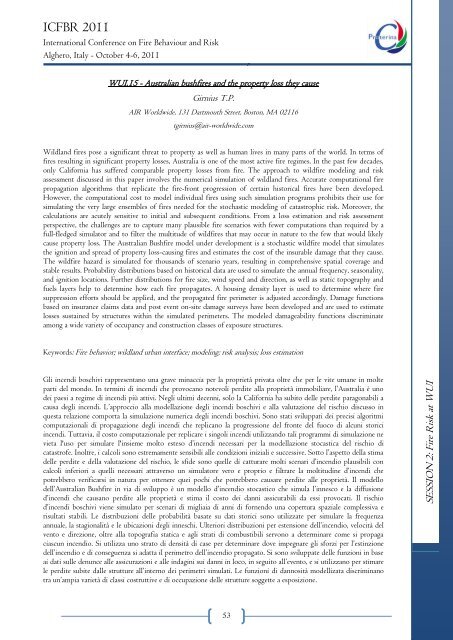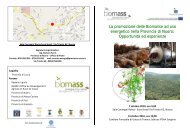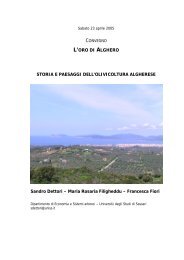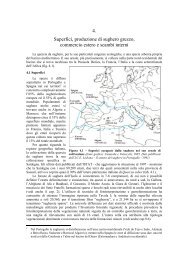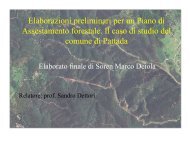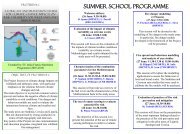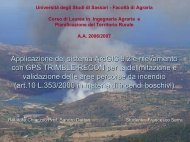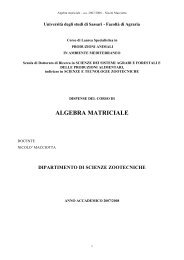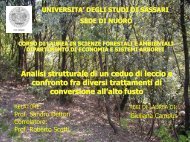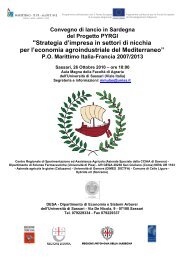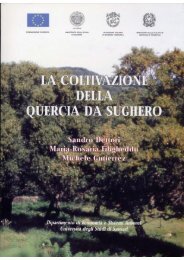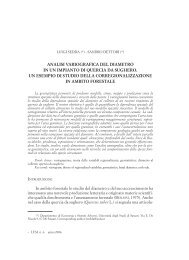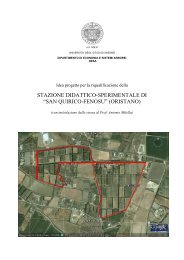BOOK degli ABSTRACT - Dipartimento di Economia e Sistemi ...
BOOK degli ABSTRACT - Dipartimento di Economia e Sistemi ...
BOOK degli ABSTRACT - Dipartimento di Economia e Sistemi ...
- No tags were found...
Create successful ePaper yourself
Turn your PDF publications into a flip-book with our unique Google optimized e-Paper software.
ICFBR 2011International Conference on Fire Behaviour and RiskAlghero, Italy - October 4-6, 2011WUI.15 - Australian bushfires and the property loss they causeGirnius T.P.AIR Worldwide, 131 Dartmouth Street, Boston, MA 02116tgirnius@air-worldwide.comWildland fires pose a significant threat to property as well as human lives in many parts of the world. In terms offires resulting in significant property losses, Australia is one of the most active fire regimes. In the past few decades,only California has suffered comparable property losses from fire. The approach to wildfire modeling and riskassessment <strong>di</strong>scussed in this paper involves the numerical simulation of wildland fires. Accurate computational firepropagation algorithms that replicate the fire-front progression of certain historical fires have been developed.However, the computational cost to model in<strong>di</strong>vidual fires using such simulation programs prohibits their use forsimulating the very large ensembles of fires needed for the stochastic modeling of catastrophic risk. Moreover, thecalculations are acutely sensitive to initial and subsequent con<strong>di</strong>tions. From a loss estimation and risk assessmentperspective, the challenges are to capture many plausible fire scenarios with fewer computations than required by afull-fledged simulator and to filter the multitude of wildfires that may occur in nature to the few that would likelycause property loss. The Australian Bushfire model under development is a stochastic wildfire model that simulatesthe ignition and spread of property loss-causing fires and estimates the cost of the insurable damage that they cause.The wildfire hazard is simulated for thousands of scenario years, resulting in comprehensive spatial coverage andstable results. Probability <strong>di</strong>stributions based on historical data are used to simulate the annual frequency, seasonality,and ignition locations. Further <strong>di</strong>stributions for fire size, wind speed and <strong>di</strong>rection, as well as static topography andfuels layers help to determine how each fire propagates. A housing density layer is used to determine where firesuppression efforts should be applied, and the propagated fire perimeter is adjusted accor<strong>di</strong>ngly. Damage functionsbased on insurance claims data and post event on-site damage surveys have been developed and are used to estimatelosses sustained by structures within the simulated perimeters. The modeled damageability functions <strong>di</strong>scriminateamong a wide variety of occupancy and construction classes of exposure structures.Keywords: Fire behavior; wildland urban interface; modeling; risk analysis; loss estimationGli incen<strong>di</strong> boschivi rappresentano una grave minaccia per la proprietà privata oltre che per le vite umane in molteparti del mondo. In termini <strong>di</strong> incen<strong>di</strong> che provocano notevoli per<strong>di</strong>te alla proprietà immobiliare, l‘Australia è unodei paesi a regime <strong>di</strong> incen<strong>di</strong> più attivi. Negli ultimi decenni, solo la California ha subito delle per<strong>di</strong>te paragonabili acausa <strong>degli</strong> incen<strong>di</strong>. L‘approccio alla modellazione <strong>degli</strong> incen<strong>di</strong> boschivi e alla valutazione del rischio <strong>di</strong>scusso inquesta relazione comporta la simulazione numerica <strong>degli</strong> incen<strong>di</strong> boschivi. Sono stati sviluppati dei precisi algoritmicomputazionali <strong>di</strong> propagazione <strong>degli</strong> incen<strong>di</strong> che replicano la progressione del fronte del fuoco <strong>di</strong> alcuni storiciincen<strong>di</strong>. Tuttavia, il costo computazionale per replicare i singoli incen<strong>di</strong> utilizzando tali programmi <strong>di</strong> simulazione nevieta l'uso per simulare l'insieme molto esteso d‘incen<strong>di</strong> necessari per la modellazione stocastica del rischio <strong>di</strong>catastrofe. Inoltre, i calcoli sono estremamente sensibili alle con<strong>di</strong>zioni iniziali e successive. Sotto l‘aspetto della stimadelle per<strong>di</strong>te e della valutazione del rischio, le sfide sono quelle <strong>di</strong> catturare molti scenari d‘incen<strong>di</strong>o plausibili concalcoli inferiori a quelli necessari attraverso un simulatore vero e proprio e filtrare la moltitu<strong>di</strong>ne d‘incen<strong>di</strong> chepotrebbero verificarsi in natura per ottenere quei pochi che potrebbero causare per<strong>di</strong>te alle proprietà. Il modellodell‘Australian Bushfire in via <strong>di</strong> sviluppo è un modello d‘incen<strong>di</strong>o stocastico che simula l‘innesco e la <strong>di</strong>ffusioned‘incen<strong>di</strong> che causano per<strong>di</strong>te alle proprietà e stima il costo dei danni assicurabili da essi provocati. Il rischiod‘incen<strong>di</strong> boschivi viene simulato per scenari <strong>di</strong> migliaia <strong>di</strong> anni <strong>di</strong> fornendo una copertura spaziale complessiva erisultati stabili. Le <strong>di</strong>stribuzioni delle probabilità basate su dati storici sono utilizzate per simulare la frequenzaannuale, la stagionalità e le ubicazioni <strong>degli</strong> inneschi. Ulteriori <strong>di</strong>stribuzioni per estensione dell‘incen<strong>di</strong>o, velocità delvento e <strong>di</strong>rezione, oltre alla topografia statica e agli strati <strong>di</strong> combustibili servono a determinare come si propagaciascun incen<strong>di</strong>o. Si utilizza uno strato <strong>di</strong> densità <strong>di</strong> case per determinare dove impegnare gli sforzi per l‘estinzionedell‘incen<strong>di</strong>o e <strong>di</strong> conseguenza si adatta il perimetro dell‘incen<strong>di</strong>o propagato. Si sono sviluppate delle funzioni in baseai dati sulle denunce alle assicurazioni e alle indagini sui danni in loco, in seguito all‘evento, e si utilizzano per stimarele per<strong>di</strong>te subite dalle strutture all‘interno dei perimetri simulati. Le funzioni <strong>di</strong> dannosità modellizata <strong>di</strong>scriminanotra un‘ampia varietà <strong>di</strong> classi costruttive e <strong>di</strong> occupazione delle strutture soggette a esposizione.SESSION 2: Fire Risk at WUI53


